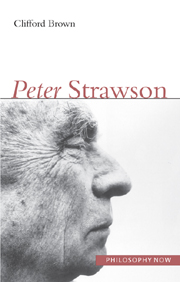Book contents
- Frontmatter
- Contents
- Abbreviations
- Introduction
- 1 “On Referring” and Introduction to Logical Theory: The basic questions
- 2 Individuals: An Essay in Descriptive Metaphysics: Towards a basic ontology
- 3 The Bounds of Sense: Kant's first Critique under analysis
- 4 Skepticism and Naturalism: Hume revisited
- 5 Analysis and Metaphysics: Summing up
- Notes
- Bibliography
- Index
2 - Individuals: An Essay in Descriptive Metaphysics: Towards a basic ontology
- Frontmatter
- Contents
- Abbreviations
- Introduction
- 1 “On Referring” and Introduction to Logical Theory: The basic questions
- 2 Individuals: An Essay in Descriptive Metaphysics: Towards a basic ontology
- 3 The Bounds of Sense: Kant's first Critique under analysis
- 4 Skepticism and Naturalism: Hume revisited
- 5 Analysis and Metaphysics: Summing up
- Notes
- Bibliography
- Index
Summary
The central question raised by Strawson in Part I of Individuals concerns the ways in which reference to individuals and particulars is obtained in the practices of ordinary language. Anything whatsoever can be identifyingly referred to, can appear as a logical subject, can appear as an individual. Thus particulars such as historical events, material objects and persons are individuals, but so too are such non-particular individuals as qualities, properties, numbers and species. There is the further question of whether our reference to a particular can be secured through the exclusive use of purely universal or general terms, or whether in every case the identification of a particular by a speaker making references rests ultimately on his own environment, and thus on the use of expressions of a demonstrative, or egocentric, or token-reflexive sort. Part II is concerned with the linguistic complements to those metaphysical or ontological questions, and at the end with the perennial question of what things may properly be said to exist.
The distinction between singular reference and predication has also been central to Strawson's entire work. We have already seen how that distinction led him to mark out three parallel distinctions: the formal one between individual and predicative variables, the functional one between referring and describing, and the grammatical one between subject and predicate. To ignore those distinctions and parallels would be to ignore Strawson's root distinction in “On Referring” between sentence and statement.
- Type
- Chapter
- Information
- Peter Strawson , pp. 51 - 92Publisher: Acumen PublishingPrint publication year: 2006



